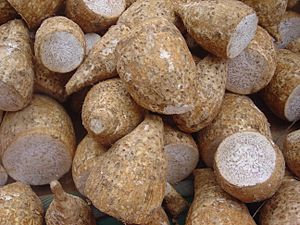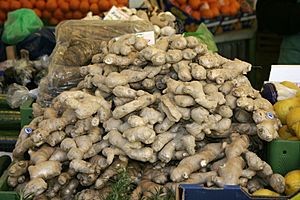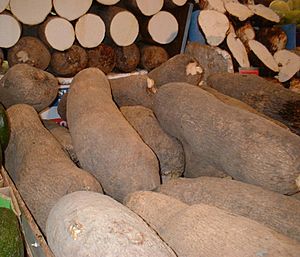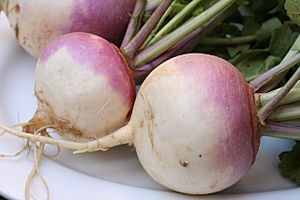Root vegetable facts for kids
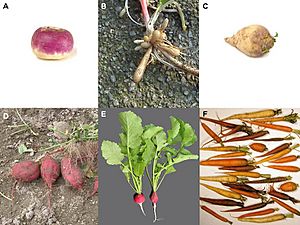
Root vegetables are parts of plants that grow underground and are used as food. Even though we call them "root vegetables," not all of them are true roots! Some are actually modified stems or other plant parts that store nutrients underground.
Common examples of root vegetables you might know include carrots, potatoes, radishes, turnips, and onions. They are packed with vitamins and minerals, making them a healthy part of your diet.
Contents
What are the different types of root vegetables?
Root vegetables can be grouped based on which part of the plant they come from. Let's explore the main types:
Modified plant stems
Some "root vegetables" are actually stems that grow underground. These stems are specially designed to store food for the plant.
Corms
A corm is a short, swollen, underground stem that stores food. It looks a bit like a bulb but is solid inside.
- Colocasia esculenta (taro) is a popular corm, especially in tropical regions.
- Amorphophallus konjac (konjac) is another example, often used to make noodles.
- Eleocharis dulcis (Chinese water chestnut) is crunchy and often found in Asian dishes.
Rhizomes
A rhizome is a stem that grows horizontally underground. New shoots and roots can grow from it.
- Zingiber officinale (ginger) is a well-known rhizome used in cooking and for its spicy flavor.
- Curcuma longa (turmeric) is another rhizome, famous for its bright yellow color and use in curries.
- Nelumbo nucifera (lotus root) is a rhizome that's popular in Asian cuisine.
Tubers
A tuber is a swollen, underground stem that stores a lot of starch.
- Solanum tuberosum (potato) is probably the most famous tuber in the world!
- Dioscorea spp. (yams) are starchy tubers, often larger than potatoes, and a staple food in many parts of Africa and Asia.
- Helianthus tuberosus (Jerusalem artichoke) is a sweet and nutty tuber.
True roots
These vegetables are actually the plant's roots, which have grown thick to store nutrients.
Taproots
A taproot is a single, large root that grows straight down into the soil. It often has smaller side roots branching off it.
- Carrot (Daucus carota subsp. sativus) is a classic example of a taproot.
- Radish (Raphanus sativus) is another common taproot, known for its peppery taste.
- Beet (Beta vulgaris) and Turnip (Brassica spp.) are also taproots that are widely eaten.
- Parsnip (Pastinaca sativa) looks like a white carrot and is a sweet taproot.
Tuberous roots
A tuberous root is a root that has become thick and fleshy to store food. Unlike tubers (which are stems), these are true roots.
- Ipomoea batatas (sweet potato) is a very popular tuberous root, known for its sweet taste and orange color.
- Manihot esculenta (cassava or yuca) is a large, starchy tuberous root that is a main food source for millions of people around the world.
Images for kids
See also
 In Spanish: Raíz alimenticia para niños
In Spanish: Raíz alimenticia para niños


